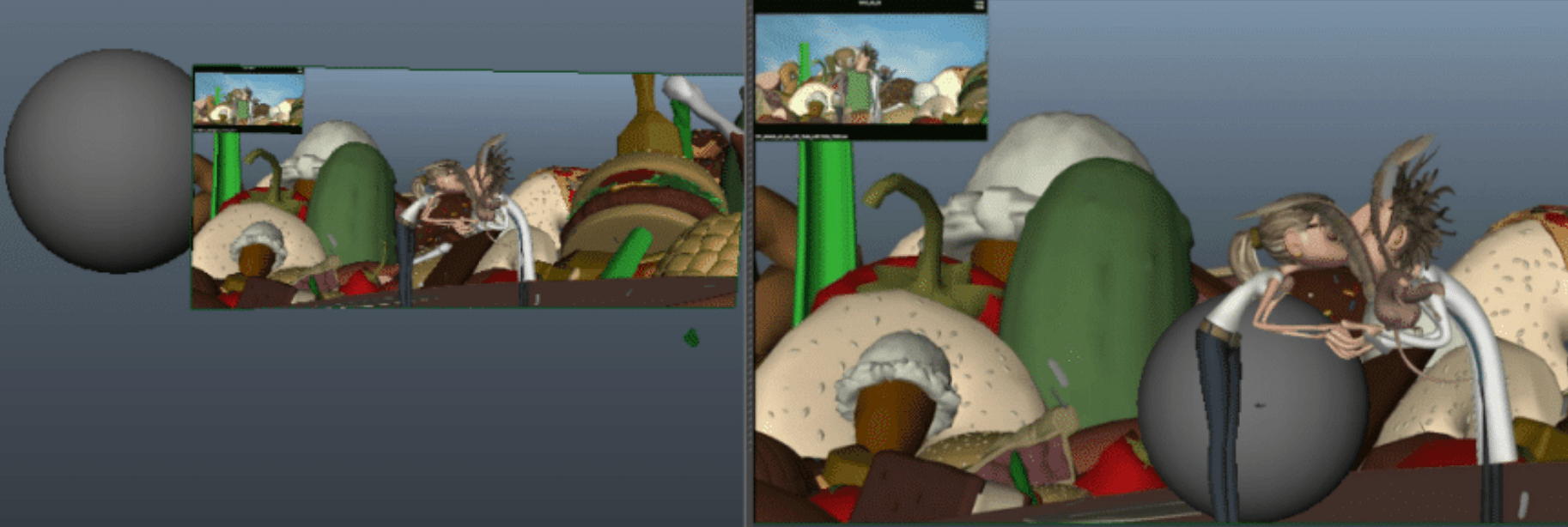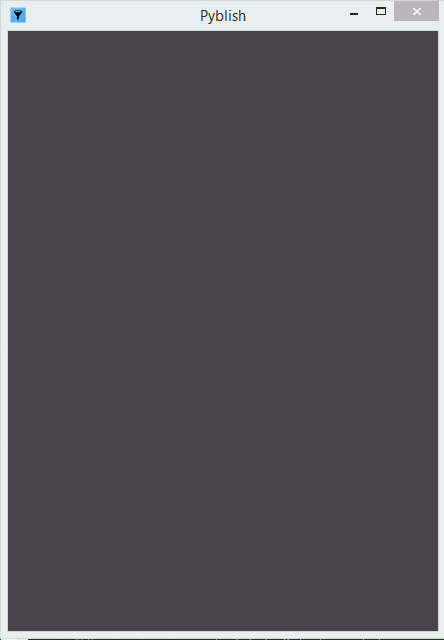Cloudy With a Chance of Meatballs I Can See Again
This mail was originally role of my series on Python for Feature Movie on my personal site, but is being ported here with minor changes. The dates have been adapted to match release dates for the projects.
In this second part of my weblog series where I go over projects that I've worked on, with a focus on how I used Python, I'll be analyzing Cloudy With A Gamble of Meatballs 2. This was my beginning animated characteristic film, and my first film at Sony Pictures Imageworks.
Before I keep I'd like to requite a little history. I'd simply left Rhythm & Hues equally my contract was expiring. Rhythm wanted to extend it, only Sony just had a better deal between a more stable task, much higher pay and the chance to work on the sequel to i of my favorite blithe films.
I was hesitant to leave because Rhythm had been a slap-up gig, but the opportunity was too good to pass up. In hindsight, this was a nifty decision because merely a few weeks afterwards, Rhythm fatefully filed for defalcation.
Then begins my journey as a Pipeline TD, having transitioned from beingness a layout creative person at Rhythm. Imageworks had taken a chance hiring me, and so far it looks to be one that'due south worked out.
Animation vs Visual Effects Films
Sony Pictures Imageworks is unique in that it's one of the few studios that works on Animated Features as well as Visual Furnishings. Seeing as I was changing from working on a Visual Furnishings Pic to my first Blithe characteristic, there were many differences to take note of.
Pros of Blitheness
Animated features take a lot going for them, and there's a reason why many artists try and work on them.
- It'due south so much more than relaxing, at a slower footstep and less overtime.
- At that place is no client, or rather, the client is on the same team as you lot.
- They understand better the struggles of creating the imagery because they're in the trenches with you, and there are fewer mad crisis times.
- Teams are larger. Only the Animation section lone can eclipse the size of an entire visual furnishings team.
- This means work is more spread out and crunch time is easier to deal with.
- You tin can bargain with tasks on a sequence level rather than a shot level most of the fourth dimension.
- This is considering entire sequences are cutting from ane source, whereas in VFX films, each shot is its own beast.
- You actually get to experience like y'all're crafting the motion picture. Even in Pipeline, you tin have some influence over the final result, rather than in Visual Effects where y'all often feel like a cog in the machine.
Cons of Blitheness
It's not always peaches and sunshine though. There are some downsides to it too.
- You work on the project for much longer. It can get quite boring seeing the same shot on your screen 2 years later.
- Teams are significantly larger, this means you don't grade as close bonds with your coworkers, and advice tin can be a real claiming. The show is now a behemothic lumbering machine, rather than an agile i.
- As a Pipeline TD, there are fewer chances to do something really cool because the teams are and so much larger, that tasks are shared around a lot, and you may have little to practice.
- There's less of a cool factor. You're often relegated to working on just a "kids film". The Visual Furnishings films are the ones that oftentimes become the oohs and ahs.
Similarities
At the end of the day though, it's non really all that dissimilar
- Our pipeline at Imageworks is largely shared between Visual Effects and Animated movies. This means for the most part, yous don't take to consider them different at all.
- Often you still have focus tests, marketing etc… on both that crave crisis time. It'south not always smooth sailing, and I never go into a projection thinking it's going to exist easy.
There were quite a few major tools that I made for this testify using Python. I'll become over them hither. These have persisted through tons of Imageworks' hereafter projects equally fundamental tools in their pipeline.
Deep Compositing for Animators
Cloudy 2 had a lot, and I hateful a lot,of background characters. This meant that shots couldn't just exist animated past a single creative person and often had to be carve up between multiple animators just to get it done in a realistic amount of fourth dimension.
Nosotros have some great oversupply tools that let us example animation around the scene, but for many of these shots nosotros needed unique, hero animation for (in some cases) a 100+ characters in a shot.
To help with this, I developed a tool that takes our Playblasts (OpenGL captures from the animators scenes) along side a depth output, so apply this inside Nuke to combine them using depth. This is a bit of a remedial apply of deep compositing, but it's quick, effective and animators can see the combined results of their scenes in nether five minutes. This was done at the asking of the animation squad who were required to pull off large fine art directed character shots, where conventional collaboration methods only weren't scaling.
Since playblasts are a natural byproduct of animators working, there was no overhead other than enabling depth write outs for all their playblasts if sure criteria were met.
This can get even further though. Using the same depth compositing, we can bring the data correct back into Maya once again equally an epitome plane. Maya's viewport supports a unmarried depth composited image airplane. This means an animator can bring in either a single playblast or a combined output, and put it on an prototype plane.

On the left y'all see the Imageplane is completely in forepart of the sphere, merely on the right it'due south composited in depth, between the characters and the foreground
From the shot camera, this 2nd epitome is at present properly composited into depth and y'all can move around the objects in the image as if they're in the scene. It's really quite cool to encounter.
Again, this process requires very little extra data, and no new workflows for the animators. It just provides a very natural way to get quick, iterative feedback on their scenes.
Texture Variations
Throughout the course of the moving picture we'd brand constant reuse of the same geometry but take varying textures for them. Traditionally lighting would but cull which texture they wanted, but for Cloudy 2, nosotros wanted Animation to have command over it because they fed into gags in the shots. Rather than have these be rigged assets or annihilation circuitous, we decided to keep it simple.
I congenital a tool that would show the animators whatsoever available textures for their assets, let them select which one they wanted and then let them use it. They could do this for several objects at in one case. One time they chose the textures, it would then be tagged to the geometry every bit an attribute that would and so be picked up by the lighting template so that lighters didn't have to even give information technology a second idea.
We used this for a lot of objects, from candybars, to ships to random objects in the scene that needed a little breakdown.
In the sequence above, all the candybars and paint explosions were handled by the texture variation tool
Group Characters in the Scene
So not all of the tools we build on a prove are this circuitous.
An example of a simpler tool I built that was pretty useful was in regards to a stadium scene in the flick. We had hundreds of characters that nosotros needed to organize into sections.
This was a elementary arrangement of:
Get a listing of all the characters in the scene. Detect their x,y,z positions in the earth. Sort them into sections based on the seats around them and their position. Like I said, something actually simple simply even that can prove to be actually useful in production.
Publishing Frontend
Like about studios, Imageworks has a very well defined publishing system to become data from one section to another.
Unfortunately, while the backend of our system was very well divers, the frontend system that was exposed to the artists was non.
This consists of these few basic ideas:
- Artists select which assets they desire to publish
- They can configure a few options
- The tool runs some validation tests
- It so publishes the scene once all tests accept passed
This gives us a reasonable safeguard against bad data making it to the next section, and lets us catch issues early on.
Our old framework for this was erstwhile, and while the design was good, the implementation made it very unfriendly for artists, but too actually hard to maintain and to add new tests. Additionally, a lot of it was in MEL.
So a coworker and I were tasked with coming up with a new framework, built from the footing up in Python. We'd still use the same backend for publishing on our computer subcontract, simply the frontend would be much more artist friendly and make it much easier for a TD on a prove to add tests.
Nosotros'd congenital this towards the end of Cloudy ii, and we decided to beta test it on the sick fated exam for Popeye

Source: https://www.gfx.dev/cloudy-with-a-chance-of-meatballs-2/
0 Response to "Cloudy With a Chance of Meatballs I Can See Again"
Post a Comment